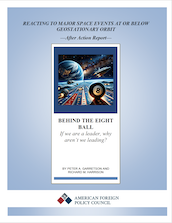For the first workshop, focus was placed on reacting to major space events at or below geostationary orbit. China has outlined a grand vision for space and over the next two decades has plans to—among other milestones—unveil incrementally improved space-based solar power satellites, a space nuclear reactor, and a squadron of spaceplanes, and to develop a mature operational co-orbital anti-satellite constellation. Each of these scenarios carries strategic significance for U.S. policymakers, and this workshop provided an opportunity to analyze them.
The six scenarios contained herein were constructed as a result of recent news headlines that have demonstrated an adversary capability or development toward a capability that could be destabilizing and elicit a reaction from the U.S. government. After the first workshop, participants universally agreed that the U.S. is currently “behind the eight ball” with regard to advancements in space—despite holding a massive head start and benefitting from the advent of reusable rockets. In comparison to China, participants were emphatic that there is a clear and decisive disparity between the two nations’ visions and strategies for space. After walking through each scenario and realizing that certain near-term developments could provide China with a decided strategic advantage, it became imperative that the U.S. should invest in certain areas to avoid having to face the daunting headlines experienced in the six scenarios. The report contains a description of each scenario, the rationale for the specific scenarios’ selection, a summary of the participant discussion, and the recommendations from the NSpC players, followed by a summary of the key takeaways and recommendations from the whole exercise. Finally, an appendix is attached containing the assessment, concerns, and recommendations of each NSpC participant along with the discussion highlighting the group’s tensions and options considered for each scenario.


